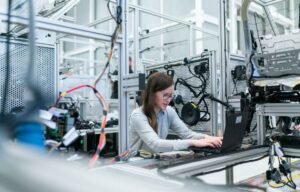Tesla vs. Rivian
The electric vehicle market has witnessed significant growth in recent years with several new players entering the scene. Two prominent names that have captured attention are Tesla and Rivian. Both companies are at the forefront of innovation in the industry, aiming to revolutionize the way we think about transportation. In this article, we will compare Tesla and Rivian in various aspects to understand their strengths, weaknesses, and overall potential in the market.
Key Takeaways
- Tesla and Rivian are major players in the electric vehicle market.
- Tesla has a head start in terms of market presence and brand recognition.
- Rivian focuses on the electric truck and SUV market.
- Tesla has a well-established charging network, giving it an edge over Rivian.
Company Background
Tesla was founded in 2003 by Martin Eberhard and Marc Tarpenning. It gained widespread attention with the release of the Tesla Roadster in 2008, the world’s first high-performance electric sports car. Tesla has since expanded its product lineup to include electric sedans, SUVs, and semi-trucks. With a market capitalization of over $500 billion, Tesla has cemented its position as the leading electric vehicle manufacturer globally.
Despite facing challenges early on, Tesla has become synonymous with electric vehicles and spearheads the industry with cutting-edge technology.
Rivian, founded in 2009 by RJ Scaringe, is a relatively newcomer to the electric vehicle market. The company has gained attention for its focus on electric trucks and SUVs, aiming to provide sustainable and versatile transportation solutions. Rivian has raised substantial funding from investors like Amazon and Ford, enabling it to invest in state-of-the-art manufacturing facilities and develop its lineup of electric vehicles.
Rivian’s unique selling point lies in its focus on the utility segment by offering all-electric trucks and SUVs, catering to outdoor enthusiasts and adventure seekers.
Vehicle Lineup
Tesla currently offers several models, including the Model S, Model 3, Model X, and Model Y. These vehicles cater to various segments of the market, ranging from luxury sedans to SUVs. Tesla vehicles are known for their performance, long-range capabilities, and advanced Autopilot features, making them a popular choice among environmentally-conscious consumers and technology enthusiasts.
Rivian’s lineup, on the other hand, consists of two vehicles: the R1T electric truck and the R1S electric SUV. These vehicles are designed for off-road capabilities while still providing a comfortable and high-performing driving experience. With features like adjustable air suspension and impressive range, Rivian vehicles are aimed at adventurous individuals seeking both utility and sustainable transportation.
Charging Infrastructure
One of the significant challenges for electric vehicle adoption is the availability of charging infrastructure. Tesla has a considerable advantage in this regard, as it operates the Tesla Supercharger Network. This network comprises thousands of charging stations globally, enabling Tesla owners to conveniently charge their vehicles and reduce range anxiety. Additionally, Tesla’s Superchargers are known for their fast charging speeds, allowing for rapid replenishment of battery levels.
Rivian, on the other hand, is in the process of developing its charging network. It plans to deploy its own network of fast chargers, known as the Rivian Adventure Network, primarily catering to customers in remote areas and popular outdoor destinations. While Rivian’s charging infrastructure is not as extensive as Tesla’s, it aims to provide convenient access to charging stations for its customers, ensuring they can embark on extended adventures without concerns of range limitations.
Market Outlook
Both Tesla and Rivian are poised for success in the growing electric vehicle market. Tesla’s early entry into the market, strong brand recognition, and proven track record give it a significant advantage. Additionally, Tesla’s extensive charging network provides a compelling reason for customers to choose their vehicles, further boosting their market presence.
Rivian, as a newcomer, brings fresh perspectives and a focus on utility-oriented vehicles. With its secured funding and unique positioning, Rivian has the potential to carve out a niche in the market, attracting consumers seeking adventure and sustainable transportation solutions.
Comparative Analysis
| Tesla | Rivian | |
|---|---|---|
| Founded | 2003 | 2009 |
| Headquarters | Palo Alto, California, United States | Plymouth, Michigan, United States |
| Most Popular Model | Model 3 | R1T (electric truck) |
Current Market Cap
As of the latest data, Tesla’s market capitalization stands at approximately $500 billion, whereas Rivian is yet to go public, and thus, its market value is not publicly available.
Investors
- Tesla: Various institutional and private investors, including notable support from CEO Elon Musk.
- Rivian: Investors include Amazon, Ford, and Cox Automotive.
Conclusion
In conclusion, both Tesla and Rivian bring unique strengths and perspectives to the electric vehicle market. While Tesla has the advantage of a well-established brand and charging network, Rivian aims to cater to a specific segment of adventure seekers and utility-focused customers. With the increasing demand for electric vehicles, it will be fascinating to see how these companies shape the future of sustainable transportation.

Common Misconceptions
Tesla vs. Rivian
There are often several misconceptions people have when it comes to comparing Tesla and Rivian, two leading electric vehicle manufacturers. One common misconception is that Tesla is the only company innovating in the electric vehicle space, while Rivian is just playing catch-up. However, this is not true.
- Rivian has made significant advancements in electric truck technology.
- Rivian’s R1T electric truck has impressive off-road capabilities.
- Rivian’s focus on adventure and outdoor lifestyle sets it apart from Tesla.
Another misconception is that Tesla’s autopilot system is superior to any other autonomous driving technology. While Tesla’s Autopilot is certainly advanced, Rivian is also investing heavily in autonomous driving capabilities.
- Rivian is developing its own autonomous driving system called Rivian Driver+.
- Rivian’s system will offer features like hands-free driving on select highways.
- Rivian aims to provide a seamless and safe autonomous driving experience.
People also often assume that Tesla’s Supercharger network is the only robust charging infrastructure available for electric vehicles. While Tesla’s network is extensive, Rivian is actively working on expanding its own charging network.
- Rivian is planning to deploy thousands of charging stations across the United States.
- Rivian is partnering with third-party charging providers to enhance its charging infrastructure.
- Rivian’s charging network will be compatible with various electric vehicle brands, including non-Rivian vehicles.
Furthermore, it is a misconception that Tesla vehicles have significantly better range compared to Rivian vehicles. While Tesla has been a leader in maximizing electric vehicle range, Rivian’s vehicles offer competitive ranges in their respective segments.
- Rivian’s R1T electric truck boasts an impressive range of over 300 miles on a full charge.
- Rivian’s upcoming electric SUV, the R1S, is also expected to have a similar range.
- Rivian focuses on offering practical and usable range for adventurous lifestyles.

Tesla and Rivian: A Comparison of Electric Vehicle Manufacturers
With the rise of electric vehicles (EVs), Tesla and Rivian have emerged as key players in this growing market. Both companies have made significant strides in revolutionizing transportation with their cutting-edge technology and commitment to sustainable energy. In this article, we will explore and compare various aspects of Tesla and Rivian to gain insights into their achievements and contributions to the EV industry.
Tesla’s Annual Revenue Growth
Over the years, Tesla has experienced remarkable revenue growth that has helped solidify its position as a leading EV manufacturer. The table below highlights Tesla’s annual revenue over the past five years, demonstrating the company’s consistent success:
| Year | Revenue (in billions) |
|---|---|
| 2016 | 7.0 |
| 2017 | 11.8 |
| 2018 | 21.5 |
| 2019 | 24.6 |
| 2020 | 31.5 |
Rivian’s Upcoming Models
Rivian has been gaining attention for its innovative electric vehicle models that offer both luxury and sustainability. Below, we outline some of Rivian’s upcoming models, showcasing the diversity and exciting features they bring to the market:
| Model | Estimated Launch | Range (miles) | 0-60 mph (seconds) |
|---|---|---|---|
| R1T Pickup Truck | 2021 | 300+ | 3.0 |
| R1S SUV | 2021 | 400+ | 3.2 |
| R2R | 2022 | 250+ | 2.9 |
Tesla’s Supercharger Network Expansion
Tesla’s Supercharger network plays a significant role in addressing concerns about long-distance EV travel by providing convenient and fast charging stations. Let’s examine Tesla’s expansion of its Supercharger network:
| Year | Supercharger Stations |
|---|---|
| 2014 | 168 |
| 2016 | 743 |
| 2018 | 1,352 |
| 2020 | 2,002 |
| 2022 (projected) | 2,500+ |
Rivian’s Safety Ratings
Rivian places a strong emphasis on safety, ensuring their vehicles provide a secure driving experience. The table below presents the safety ratings of Rivian’s models according to the National Highway Traffic Safety Administration (NHTSA):
| Model | Overall Rating | Frontal Crash | Side Crash | Rollover |
|---|---|---|---|---|
| R1T Pickup Truck | 5 Stars | 5 Stars | 5 Stars | 5 Stars |
| R1S SUV | 5 Stars | 5 Stars | 5 Stars | 5 Stars |
Tesla’s Global Vehicle Deliveries
Tesla’s influence extends worldwide, as demonstrated by the global delivery numbers of their electric vehicles:
| Year | Deliveries |
|---|---|
| 2015 | 50,580 |
| 2017 | 103,081 |
| 2019 | 367,500 |
| 2020 | 499,550 |
| 2022 (estimated) | 700,000+ |
Rivian’s All-Wheel Drive and Ground Clearance Comparison
Rivian’s commitment to adventure and off-road capabilities is evident in their all-wheel drive and ground clearance specifications. Let’s explore these features:
| Model | AWD | Ground Clearance (inches) |
|---|---|---|
| R1T Pickup Truck | Standard | 14.0 |
| R1S SUV | Standard | 14.4 |
Tesla’s Autopilot Mileage
Tesla’s Autopilot system has been continuously tested and improved over the years. Here’s a look at the number of miles driven by Tesla vehicles on Autopilot:
| Year | Miles Driven on Autopilot (in millions) |
|---|---|
| 2015 | 0.22 |
| 2017 | 1.33 |
| 2019 | 3.27 |
| 2020 | 5.24 |
| 2022 (estimated) | 7.8+ |
Rivian’s Battery Pack Options
Rivian offers different battery pack options to cater to different driving needs, as shown in the table below:
| Model | Battery Pack Options (kWh) |
|---|---|
| R1T Pickup Truck | 105, 135, 180 |
| R1S SUV | 105, 135, 180 |
Tesla’s Energy Storage Deployed Capacity
Tesla not only focuses on electric vehicles but also plays a significant role in renewable energy storage. Here’s a glimpse at Tesla’s deployed energy storage capacity:
| Year | Deployed Capacity (in MWh) |
|---|---|
| 2015 | 230 |
| 2017 | 1,040 |
| 2019 | 2,480 |
| 2020 | 3,550 |
| 2022 (estimated) | 4,100+ |
As the electric vehicle industry expands, Tesla and Rivian have made significant contributions and advancements to the market. Tesla’s established presence, revenue growth, and Supercharger network expansion demonstrate its dedication to making EVs accessible and convenient for all. Rivian, on the other hand, has captured attention with its upcoming models, focus on safety, and commitment to adventure and sustainability. Both companies continue to push the boundaries of electric transportation, driving the industry forward and inspiring innovation for a greener future.
Frequently Asked Questions
What are some key differences between Tesla and Rivian?
Tesla and Rivian are both electric vehicle manufacturers, but they differ in various aspects. While Tesla is known for its established position in the market and a wide range of electric vehicle options, Rivian is a relatively new player focusing on electric adventure vehicles and pickups. Tesla has a larger Supercharger network, while Rivian plans to establish its own charging infrastructure. Additionally, Rivian vehicles are built with ruggedness and off-road capability in mind, whereas Tesla’s vehicles are geared towards luxury, performance, and technology.
Which company has a longer history in the electric vehicle industry?
Tesla has a longer history in the electric vehicle industry compared to Rivian. Tesla was founded in 2003, whereas Rivian was founded in 2009. As a result, Tesla has had more time to establish itself, launch multiple successful vehicle models, and build a strong presence in the market.
Are Rivian’s vehicles available for purchase right now?
As of now, Rivian’s vehicles are not available for purchase. However, pre-orders have been opened for some of their upcoming models. The Rivian R1T electric pickup truck and the R1S electric SUV can be reserved through their official website, and deliveries are expected to begin in the near future.
Can I charge a Rivian vehicle using Tesla’s Supercharger network?
No, you cannot currently charge a Rivian vehicle using Tesla’s Supercharger network. Tesla Superchargers are designed specifically for Tesla vehicles and use a proprietary charging standard. Rivian is developing its own charging infrastructure called the “Adventure Network” that will be compatible with their vehicles.
How do Tesla and Rivian compare in terms of range?
Tesla currently offers a range of electric vehicles with varying range options. Their Model S Long Range, for example, boasts a range of over 400 miles. On the other hand, Rivian’s R1T and R1S are expected to have ranges of around 300 miles. It’s important to note that range can vary depending on factors such as driving conditions, weather, and vehicle configuration.
Are Tesla’s vehicles more expensive than Rivian’s?
Tesla and Rivian offer vehicles at different price points. Tesla’s lineup includes luxury vehicles like the Model S and Model X, which tend to have higher starting prices. However, Tesla also has more affordable options such as the Model 3 and Model Y. Rivian is positioning its vehicles as premium adventure electric vehicles, and initial pricing suggests they will be in a similar price range as Tesla’s luxury models.
Do Tesla and Rivian offer similar warranty options?
Both Tesla and Rivian offer warranties for their vehicles. Tesla typically provides a limited warranty for 4 years/50,000 miles, whichever comes first, along with an 8-year/unlimited-mile warranty on their battery and drive unit. For Rivian, specific warranty details have not been released yet, but it can be expected that they will offer warranties similar to industry standards.
Which company has a larger network of service centers?
Tesla currently has a larger network of service centers compared to Rivian. Tesla has established numerous service centers worldwide to support their growing customer base. Rivian, being a newer company, is in the process of building up its service network as it ramps up production and sales.
Are Tesla and Rivian involved in the development of autonomous driving technology?
Yes, both Tesla and Rivian are involved in the development of autonomous driving technology. Tesla has been at the forefront of autonomous driving advancements with their Autopilot feature, which provides semi-autonomous capabilities. Rivian has also expressed interest in autonomous driving technology and plans to offer over-the-air updates to enhance its vehicles’ capabilities.
Can I reserve a Tesla or Rivian vehicle online?
Yes, both Tesla and Rivian offer online reservation systems. Tesla allows customers to reserve their vehicles directly through their website. Rivian, too, allows customers to place pre-orders for their vehicles online, securing a place in line for delivery in the future.




